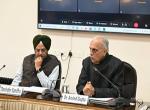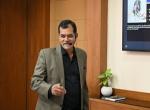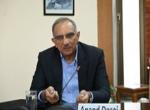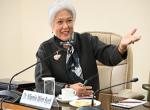A VIF delegation led by its Director, Gen (Retd) N C Vij, visited Hanoi and Ho Chi Minh city from 02 to 05 Nov 2014. The delegation included Vice Admiral (Retd) KK Nayyar, Chairman, Board of Trustees, VIF, Lt Gen (Retd) R K Sawhney, Ambassador TCA Rangachari and Vice Admiral (Retd) Anup Singh.
In Hanoi, the delegation interacted with several academic institutions and think tanks including Diplomatic Academy of Vietnam, Institute of Indian and South West Asian Studies, Vietnam Academy of Social Sciences, Institute for Defence International Relations (IDIR) and Vietnam Centre for Economic and Policy Research.
At Ho Chi Minh City, they exchanged ideas on India-Vietnam Strategic Partnership with Fulbright Economics Teaching Program and the Department of External Relations, Ho Chi Minh City.
During interaction with the Diplomatic Academy of Vietnam on 03 Nov, reciprocal presentations, giving respective points of view, were made by the two sides on the following subjects:-
(a) Emerging Strategic Environment in the Asia Pacific Region and its Implications
(b) Politico-Strategic and Economic Cooperation between India and Vietnam: Issues and Prospects
(c) Indo-Vietnam Defence and Security Cooperation and the Way Forward
(d) Security and stability in the South China Sea
Discussions with all other organisations flowed from the above interaction, and some interesting new perspectives emerged from their side.
On Strategic Partnership
It was agreed that India and Vietnam have centuries of friendship and mutual respect, and have embarked upon a strategic partnership for taking forward avenues of cooperation, and to neutralize common security challenges. India’s shift from “Look East” to “Act East” is being complimented by Vietnam’s initiative in its “Look West” policy towards India.
The commonality of our interests, demand a closer relationship. India stands for freedom of navigation, and Vietnam looks forward to support in all spheres – including defence cooperation, maritime security, and maintenance of tranquility in the South China Sea.
While defence and security cooperation is proceeding as planned, the pace of cooperation in fields of education and training of Vietnamese Armed Forces needs to be expanded, and expedited further.
Economy
- Tourism. There was consensus that much more needed to be done in terms of people-to-people contact through promotion of tourism – including religious tourism (the Indian connection with the Cham civilization/My Son sanctuary; and Vietnamese interest in Bodh Gaya, were cited as examples). Vietnam receives 8 Million footfalls annually, of which Indians account for an insignificant number. The same holds true of Vietnamese visiting India. It was also felt that unlike the rest of ASEAN, Bollywood had neglected Vietnam. Introduction of Indian cinema in Vietnam will spread greater awareness amongst Vietnamese, who will automatically get enthused in visiting, and doing business with India.
- Business. The Fulbright Economics Centre gave an interesting insight on why Vietnam does not diversify its import of inputs/raw materials away from China, and shift to India. The dynamics of business in this respect are left to the principal MNCs who themselves decide where to source material for the supply chain. Therefore, there may be a case for a dialogue with all MNCs, and instilling confidence in them about the ease of doing ‘profitable’ business with India. The Vietnam Centre for Economic and Policy Research pointed towards the strength of Indian Economy, and the impressive fundamentals of India’s soft power which it must utilize at a time that many Western business houses are moving out of China; and India could fill the void as an alternate supplier to those companies. (Many businesses are already relocating from China to Vietnam).
- Connectivity. Commencement of direct flights between Delhi and Ho Chi Minh City by Jet Airways/Vietnam Airlines this month was the best thing that should have actually happened a long time ago. The next steps to include Hanoi, and the proposed road connectivity from Kolkata to Hanoi via Myanmar, Cambodia, and Laos will make people focus more and more towards India, and should be expedited to earn benefits for both sides.
- Preferential Trade Agreement. Removing trade barriers and eliminating tariffs by both sides will encourage and expand bilateral trade. There was consensus that the current level of 8 Bn $ worth of trade is too low, and the target of 15 Bn $ by 2020, was far too conservative for the two rising economies who are strategic partners since 2007. Therefore, much more needs to be done to diversify the basket of trade between the two. Similarly, more joint projects, and FDI from India is a possibility that should be encouraged.
- Energy Sector. Satisfaction was expressed on the joint exploration projects in progress between OVL and Petro Vietnam. There are avenues for greater participation, without worrying about protests by third parties in the South China Sea.
Education and Training
There was a desire expressed by the two sides on expanding cooperation between academic institutions, and inviting much larger number of students in universities of both sides. Apart from promoting people to people contact, this initiative will also infuse awareness of the two peoples and institutions about each other’s strengths and avenues for cooperation in all fields.
South China Sea Imbroglio
It was agreed that the security situation in the South China Sea is not conducive for peace and tranquility in the region. China has expanded its repertoire of claims from territorial disputes with land neighbours to islands and a large maritime zone in the South China Sea. This scenario has been compounded by military posturing, and positioning of oil rigs in the Exclusive Economic Zone of others – notably of Vietnam. It was felt that the US Rebalancing is a welcome sign, and will help ease tensions in the semi enclosed sea. India’s support to Vietnam, in its pursuit of justice and legitimate claims, was assured.
The Indo-Vietnam strategic partnership is a result of the shared spirit of nationalism in the two countries, ancient civilizational contacts, and common goals in today’s economic and security environment. It was agreed that the world is moving too fast and that there is an urgent need to take our relationship to higher levels of economic and security cooperation through increased interaction. There is much expectation and we must seize on the opportunities available.







